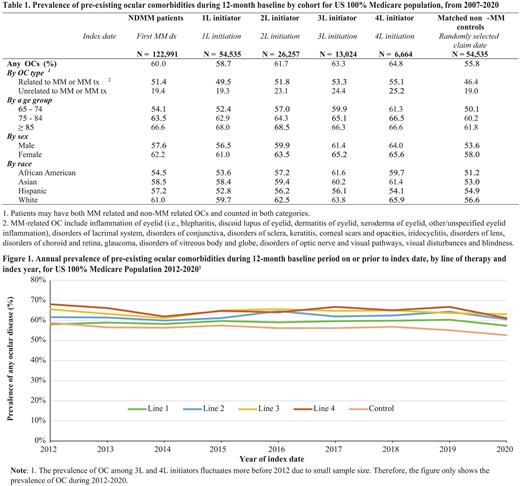Abstract
Background Multiple myeloma (MM) predominantly affects older patients (median age at diagnosis 69 years [Padala SA, Barsouk A, Barsouk A, Rawla P, Vakiti A, Kolhe R, Kota V, Ajebo GH. Epidemiology, staging, and management of multiple myeloma. Medical Sciences. 2021 Jan 20;9(1):3]) in whom comorbidities are prevalent. Some anti-MM therapies can be associated with ocular toxicities and require careful attention when used among patients with pre-existing ocular comorbidities (OCs). A study found that 39% of adult (>18 years of age) MM patients had pre-existing OCs (e.g., disorders of lens, glaucoma) and the prevalence increased with age. Given the potential implication of comorbid OCs on MM treatment decisions, this study aimed to describe the annual prevalence of OCs among Medicare beneficiaries with MM during 2007-2020 in the US.
Methods Using a 100% sample of Medicare claims data, beneficiaries ≥65 years with newly diagnosed MM (NDMM; defined as the first MM diagnosis after a 1-year clean period) who received up to 4 lines of systemic therapies (LOT) for MM during 2007-2020 were selected. The following cohorts were identified: NDMM patients, NDMM patients who received 1L treatment, relapsed/refractory MM (RRMM) patients who initiated 2L, 3L or 4L treatment. The index date was the date of NDMM diagnosis or LOT initiation date. Patients were required to have ≥12 months of continuous Medicare enrollment before the index date. LOT was defined based on a clinically validated adaptation of published algorithms. A non-MM general population control cohort was also selected by matching to the 1L initiator cohort by age group (i.e., 65-74, 75-84, and ≥85), sex, and race, with a randomly selected medical claim date as the index date. Patients were considered to have an OC if they had a claim with any OC ICD-9/10 diagnosis codes in the 12 months prior to index date. OCs (e.g., disorders of conjunctiva, lens, choroid, retina, glaucoma) were considered potentially MM-related disease manifestations or MM treatment-related toxicity based on published literature and clinical expert opinion. The prevalence of OCs, defined by the percent of patients with ≥1 OC among all eligible patients in a cohort, was reported by age group, sex, race, and index year.
Results The median age for NDMM was 76.5 years (N=122,991). Among patients who received treatment, the median age was 75.8, 76.4, 77.0, and 77.5 years at 1L, 2L, 3L, and 4L initiation. About half of patients (49.1-51.3% across groups) were women, and 79.9-84.4% were White. The mean modified Charlson Comorbidity Index (excluding malignancy conditions) was 2.1 among NDMM and 1.9 among treated patients. Proteasome inhibitors and immunomodulatory drugs were the most used treatments in all LOTs and monoclonal antibody therapies were more commonly used in later LOTs (3.2% in 1L vs. 30.8% in 4L).
The prevalence of OCs among NDMM was 60.0% (Table 1). Among treated patients, the prevalence of OCs was 58.7% at 1L initiation, compared to 55.8% in the matched general population, and even higher in RRMM patients (61.7%, 63.3%, and 64.8% prior to 2L, 3L, and 4L initiation, respectively). This trend was observed across all OC categories, among MM-related OCs, and across all age groups. The most prevalent OCs were disorders of lens (32.9% in NDMM, 33.4% in 1L initiators, and 32.3% in general population) and disorders of choroid and retina (22.9% in NDMM, 21.6% in 1L initiators, and 19.6% in general population). The prevalence of disorders of eyelid, lacrimal system, and orbit had the greatest increase from 1L (17.0%) to 4L (23.9%), followed by disorders of lens (from 33.4% in 1L to 36.8% in 4L). Women and White patients had a higher prevalence of OCs than men and minorities, respectively, in all LOTs and the prevalence increased with age. The prevalence of OCs by LOT was stable over the years (Figure 1).
Conclusions Sixty percent of newly diagnosed multiple myeloma patients among US Medicare beneficiaries have an existing ocular comorbidity at diagnosis. Prevalence of OCs, especially MM and MM treatment-related OCs, is higher among patients who are treated than the general population and the prevalence increases with advancing lines of therapy. Ocular comorbidities are more prevalent among White than among African American, Asian and Hispanic patients and among women than men. Given the magnitude, ocular comorbidities should be factored into the treatment decisions for the elderly patients with MM.
Disclosures
Ma:Regeneron Pharmaceuticals, Inc.: Current Employment, Current equity holder in private company, Current holder of stock options in a privately-held company. Jalbert:Regeneron Pharmaceuticals, Inc.: Current Employment, Current equity holder in private company, Current holder of stock options in a privately-held company. Zhou:Regeneron Pharmaceuticals, Inc.: Consultancy. Zhou:Regeneron Pharmaceuticals, Inc.: Consultancy. Downes:Regeneron Pharmaceuticals, Inc.: Consultancy. Zhang:Regeneron Pharmaceuticals, Inc.: Consultancy. Chi:Regeneron Pharmaceuticals, Inc.: Current Employment, Current equity holder in private company, Current holder of stock options in a privately-held company. Hampp:Regeneron Pharmaceuticals, Inc.: Current Employment, Current equity holder in private company, Current holder of stock options in a privately-held company. Song:Regeneron Pharmaceuticals, Inc.: Current Employment, Current equity holder in private company, Current holder of stock options in a privately-held company. Noguera-Troise:Regeneron Pharmaceuticals, Inc.: Current Employment, Current equity holder in private company, Current holder of stock options in a privately-held company. Weyne:Regeneron Pharmaceuticals, Inc.: Current Employment, Current equity holder in private company, Current holder of stock options in a privately-held company. Kroog:Regeneron Pharmaceuticals, Inc.: Current Employment, Current equity holder in private company, Current holder of stock options in a privately-held company. Rodriguez Lorenc:Regeneron Pharmaceuticals, Inc.: Current Employment, Current equity holder in private company, Current holder of stock options in a privately-held company.
Author notes
Asterisk with author names denotes non-ASH members.


